In this article, we want to discuss how to Scan, Detect and Remove Malware on your Windows 11 PC
If your Windows 11 PC slows down, your screen is full of annoying ads, your browser settings change, or there is a strange increase in internet activity on your system, it’s possible that your device has malware installed. This guide will teach you how to remove all types of malware from Windows 11 by following easy step-by-step instructions.
Windows 11 computer is infected with malware
Malware is a general term for any software designed to cause harm. Short for “malware,” malware can damage files, steal sensitive data, and even take your device hostage.
The most common types of malware for Windows 11 are adware, browser hijackers, and unwanted programs. However, Trojan, Ransomware, and other malware are known to target Windows 11 users more than any other operating system.
Malware can spread in a number of ways: when you download and install an infected program, when you click on an infected link or open a malicious email attachment, or sometimes when you use contaminated physical media such as a USB drive.
Here are some common signs that you have adware installed on your computer:
- Your web browser’s default home page has been changed
- Blocked the access to security related websites
- You will be redirected to web pages other than the ones you intended to visit
- You get many web browser pop-up messages
- It shows an unexpected or strange toolbar at the top of your web browser
- Your computer is running slower than normal
- Your computer freezes, hangs or becomes unresponsive
- There are new icons on your desktop that you don’t recognize
- Your computer will restart automatically (but not restart due to Windows Update)
- You see unusual error messages (eg, messages that say there are missing or corrupt file folders)
- You don’t have Access Control Panel, Task Manager, Registry Editor, or Command Prompt.
To scan your Windows 11 PC for malware and remove it for free, please use the guide below.
Clean an infected Windows 11 computer
This malware removal guide may seem overwhelming due to the number of steps and many programs involved. We have written it this way only to provide clear, detailed, and easy-to-understand instructions that anyone can use to remove malware for free. Please do all the steps in the correct order. If you have any questions or doubts at any point, stop by and ask for our assistance.
Follow the steps below to remove all types of malware from Windows
- STEP 1: Uninstall Malicious Programs in Windows 11
- STEP 2: Using Malwarebytes software to remove adware and browser hijackers in Windows 11
- STEP 3: Using HitmanPro to Remove Trojans and Other Malware Viruses in Windows 11
- STEP 4: Using AdwCleaner software to remove adware and malicious browser policies in Windows 11
- STEP 5: Use the Emsisoft Emergency Kit to double-check for malware
- STEP 6: Removing malicious browser extensions and search settings
STEP 1: Uninstall Malicious Programs in Windows 11
In the first step of our process, we will check if any malicious programs are installed on your computer. Sometimes the adware may have usable uninstall entries that can be used to remove it.
1. Open Windows Settings.
First, press “WINDOWS+I” on your keyboard to open Windows Settings. You can right-click your Start button and select “Settings” from the list.

2. Click on “Applications”, then select “Applications and Features”.
When Settings opens, click “Apps” in the sidebar, then select “Apps & Features”.

3. Find and uninstall all malicious programs
In Apps & features settings, scroll down to the apps list and look for unknown or suspicious programs. When you find a malicious program, click the three-dot button next to it and select “Uninstall” from the menu that appears.
NOTE
Look for any suspicious programs that might be behind all the drama – anything you don’t remember downloading or that doesn’t look like a genuine program. If you can’t find any malicious programs on your computer, you can continue with the second step of this guide.

4. Use the on-screen prompts to uninstall programs
In the next message box, confirm the uninstall process by clicking “Uninstall“. Then follow the prompts to uninstall the malicious program. Be sure to read all prompts carefully, as some malicious programs try to sneak things in hoping you won’t read them closely.

STEP 2: Using Malwarebytes software to remove adware and browser hijackers in Windows 11
In the second step of our process, we’ll install and run a scan with Malwarebytes to remove browser hijackers, adware, and potentially unwanted programs from your computer.
Malwarebytes is the most popular and most used anti-malware software for Windows, and for good reason. It is capable of killing most of the malware that other software can avoid, without costing you any money. When it comes to cleaning an infected device, Malwarebytes is always free. We recommend it as an essential tool in the fight against malware.
1. Download “MALWAREBYTES” Software Free.
Use the link below to download Malwarebytes software to your device
https://malwaretips.com/blogs/downloads-malwarebytes-for-windows/
2. Double-click the Malwarebytes setup file.
When Malwarebytes is finished downloading, install Malwarebytes on your computer by double-clicking the MB setup file. Downloaded files are usually saved to the Downloads folder.

You will be presented with a User Account Control popup asking if you want to allow Malwarebytes to make changes to your device. If this happens, you must click “Yes” to continue installing Malwarebytes.

3. Install Malwarebytes using the on-screen prompts
When the Malwarebytes installation begins, you will see the Malwarebytes setup wizard that guides you through the installation process. The Malwarebytes installer will first ask you what type of computer you are installing the program on, click Personal computer or Work computer.

On the next screen, click “Install” to install Malwarebytes on your computer.

When your Malwarebytes installation is complete, the program will open to the Welcome to Malwarebytes screen. Click the “Start” button.
4. Click on “Scan”.
To scan your computer with Malwarebytes, click the “Scan” button. Malwarebytes automatically updates the antivirus database and starts scanning your computer for adware and other malicious programs.

5. Stay for the Malwarebytes scan to complete.
Malwarebytes scans your computer for adware and other malicious programs. This process may take a few minutes, so we suggest you do something else and check the scan status periodically to see when it’s finished.

6. Click on “Quarantine”.
When the scan is complete, Malwarebytes will present you with a screen showing the detected malware infections. To remove browser hijackers and other malicious programs that Malwarebytes has detected, click the “Quarantine” button.

7. Restart computer.
Malwarebytes will now remove all adware and other malicious programs and registry keys it finds. Malwarebytes may ask you to restart your computer to complete the malware removal process.

Once the malware removal process is complete, you can close Malwarebytes and continue with the rest of the instructions.
STEP 3: Using HitmanPro to Remove Trojans and Other Malware Viruses in Windows 11
In this third step, we will install HitmanPro to scan your Windows 11 PC to scan and remove Trojan Horses and other malware.
HitmanPro is a second opinion scanner. It takes a unique cloud-based approach to malware scanning. HitmanPro scans active files for behavior and suspicious activity in locations where malware is commonly found. If it finds an already unknown suspicious file, HitmanPro sends it to its cloud to be scanned by two of the best antivirus engines, Bitdefender and Kaspersky.
Although HitmanPro is stock software and costs $24.95 for a year on 1 computer, there is actually no limit on scanning. The limit starts only when you need to remove or quarantine malware detected by HitmanPro on your system, at which point, you can activate the 30-day trial to enable cleaning.
1. Download HitmanPro.
You can download HitmanPro by clicking the link below.
2. Install HitmanPro.
When HitmanPro is finished downloading, double-click
32-bit versions of Windows–“hitmanpro.exe”
64-bit versions of Windows–“hitmanpro_x64.exe” to install the program on your computer.Usually, the downloaded files are saved to the Downloads folder.

You will be presented with a User Account Control popup asking if you want to allow HitmanPro to make changes to your device. If this happens, you must click “Yes” to continue the installation.

3. Use the on-screen prompts.
When HitmanPro starts you will be presented with the splash screen as shown below. Click on the “Next” button to scan the system.


4. Stay for the HitmanPro scan to complete.
HitmanPro will now start scanning your computer for malware. The process takes a few minutes to complete.
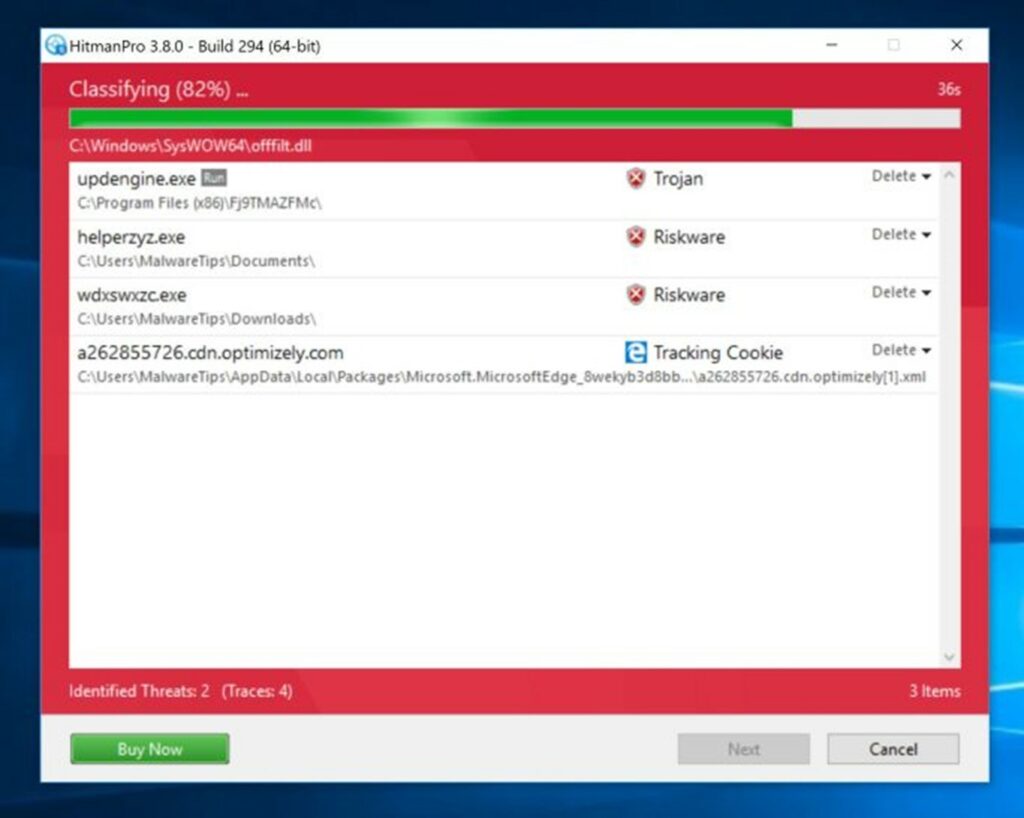
5. Click –>“NEXT”.
When HitmanPro finishes scanning, it will display a list of all the malware the program found. Click on the “Next” button to remove the malware.

6. Click –>“ACTIVATE FREE LICENSE”
Click the “Activate Free License” button to start the free 30-day trial and remove all malware from your computer.

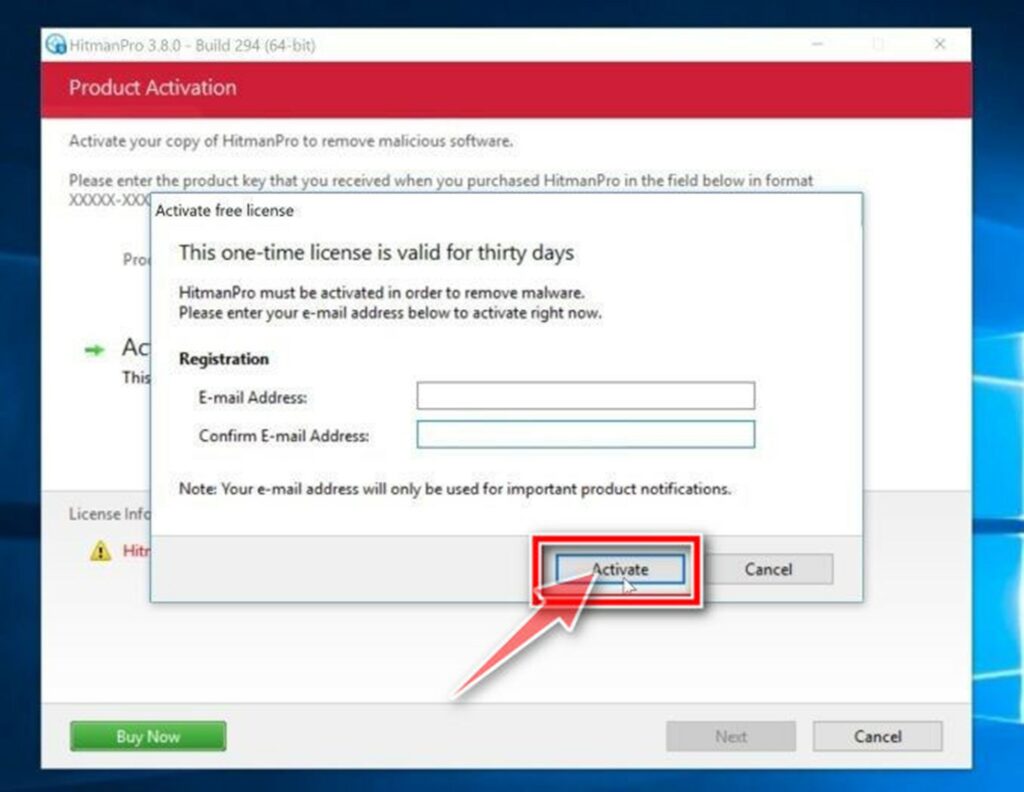
Once the process is complete, you can close HitmanPro and continue with the rest of the instructions.
STEP 4: Using AdwCleaner software to remove adware and malicious browser policies in Windows 11
In the fourth step of our process, we’ll use AdwCleaner to remove malicious browser policies and adware from your computer.
AdwCleaner is a popular free on-demand scanner that can detect and remove malware that even the most popular antivirus and anti-malware applications fail to find. This on-demand scanner includes many tools that can be used to fix adware or browser hijacking side effects.
1. Download AdwCleaner.
Use the link below to download AdwCleaner software to your device
https://malwaretips.com/blogs/downloads-adwcleaner/
2. Double-click the Setup File.
To have a start double click on the AdwCleaner file named “adwcleaner_x.x.x.exe”. Usually, the downloaded files are saved to the Downloads folder.

Sometimes, you may be presented with a User Account Control dialog asking if you want to run this file. Turn on “Reset Chrome Policies”.

3. Turn On “Reset Chrome policies”.
After AdwCleaner starts, on the left side of the window, click on “Settings“. Then enable “Reset Chrome Policies”.

4. Click –> “Scan Now”.
On the left side of the window, click on “Toolbar” and then click “Scan Now” to scan the system.

5. Stay for the AdwCleaner scan to complete.
Now AdwCleaner will scan your computer for malware. This process may take several minutes.
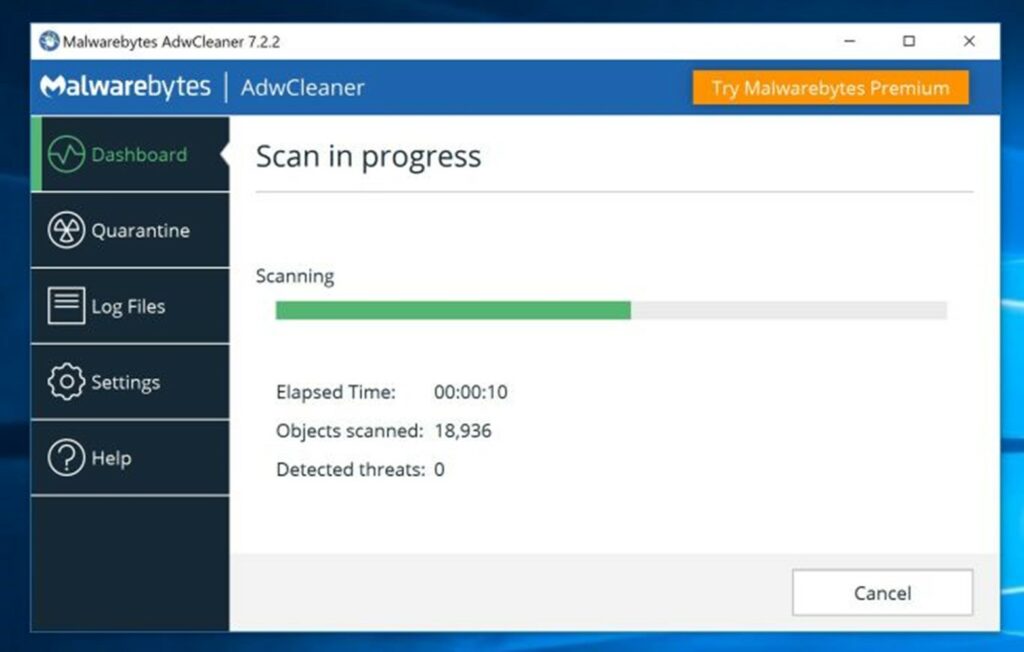
6. Click –> “Clean & Repair”.
When AdwCleaner is finished it will display a list of all the malware the program found. Click on the “Clean & Repair” button to remove malicious programs from your computer.

7. Click –> “Clean & Restart Now”
When the malware removal process is complete, AdwCleaner may require you to restart your device. To finish the removal process Click on the “Clean & Restart Now” button

Once the process is complete, you can close Adwcleaner and continue with the rest of the instructions.
STEP 5: Use the Emsisoft Emergency Kit to double-check for malware
While previous scans are more than adequate, we recommend Emsisoft Emergency Kit to users who still have malware issues or want to make sure their computer is 100% clean.
Emsisoft Emergency Kit is a free and powerful on-demand scanner. It can be used to remove viruses, trojans, spyware, adware, worms and other malicious programs.
1. Download “Emsisoft Emergency Kit”
Use the link below to download Emsisoft Emergency Kit software to your device
https://malwaretips.com/blogs/downloads-emsisoft-emergency-kit/
2. Install the “Emsisoft Emergency Kit”
Double-click on the EmsisoftEmergencyKit setup file to start the installation process, then click on the “Install” button.

3. Start –> Emsisoft Emergency Kit
The “EEK” folder (C:\EEK) should now be open on your desktop. To get Emsisoft, click on the file “Start Emsisoft Emergency Kit” to open this program.

You may be presented with a User Account Control dialog asking if you want to run this file. If this happens, you must click “Yes” to continue the installation.

4. Click on “Malware Scan”.
Emsisoft Emergency Kit will start and ask you for permission to update it. After the update process is complete, click on the “Scan” tab and perform “Malware Scan”.

Emsisoft Emergency Kit now scans your computer for malware. This process may take several minutes.
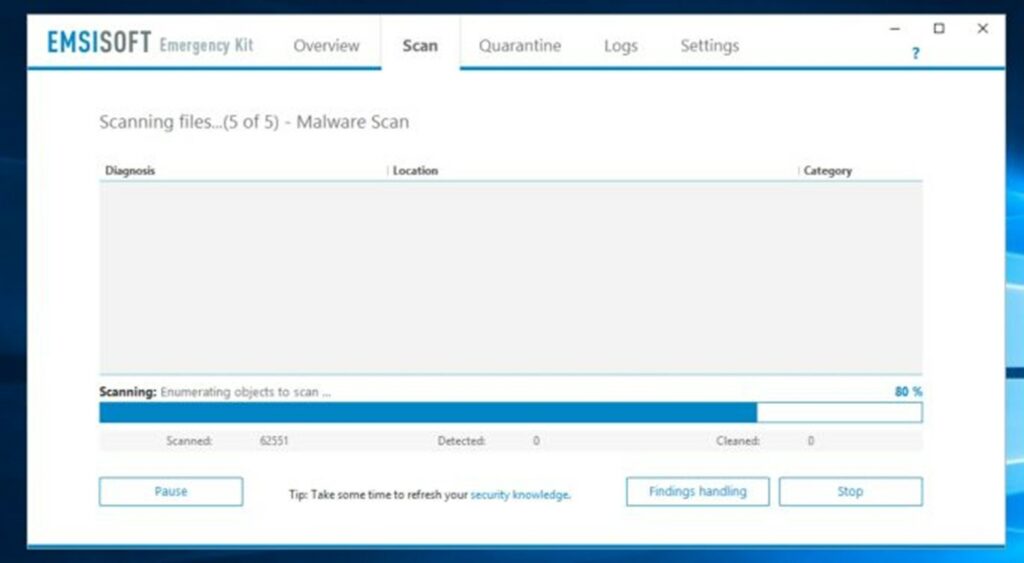
5. Click –>“Quarantine Selected”
When the Microsoft scan is complete, you will be presented with a screen reporting that malicious files have been detected on your computer. To remove malware, click on “Selective Quarantine”.

When the malware removal process is complete, Emsisoft Emergency Kit may require you to restart your computer. Click the “Reebok” button to restart your computer. After you finish the process of restarting your computer, you can close Emsisoft Anti-Malware and continue with the rest of the instructions.
STEP 6: Removing malicious browser extensions and search settings
In this final step, we’ll manually check your browser for malicious extensions installed without your knowledge
Chrome
Remove malicious browser and adware extensions from Google Chrome
To remove adware and malicious browser extensions from Google Chrome, we remove the browser extension and then check the settings.
1. Remove “Malicious Browser Extensions”
In the upper right corner, click on Chrome’s main menu button, represented by three vertical dots.When the drop-down menu appears, click on “More Tools“. Click on “Advanced“.

The “Extensions” screen will be displayed with a list of all extensions installed in Chrome. Scroll through the list until you find an unknown or suspicious extension, then click on “Remove” to remove it.
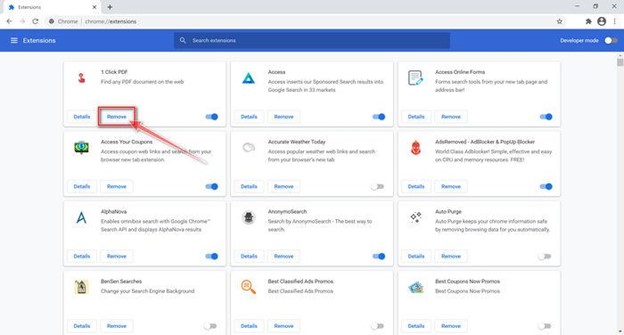
2. Change the search engine to Google.
In the upper right corner, click on Chrome’s main menu button, represented by three vertical dots. When the drop-down menu appears, click on “Settings“.
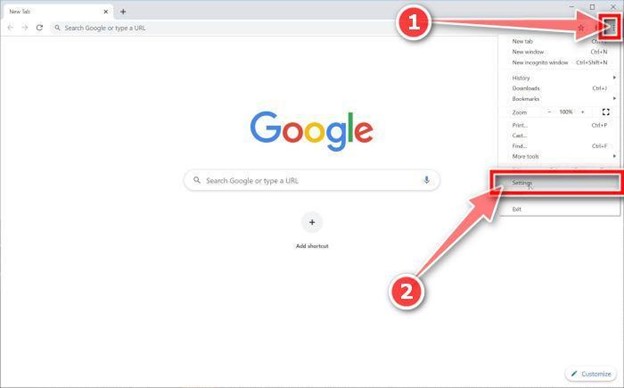
On the left side of the window, click on “Search Engine”, then click “Manage Search Engines…”. Look for unwanted search engines in the list that opens, click the three vertical dots next to the URL when located, and select “Remove from list”.
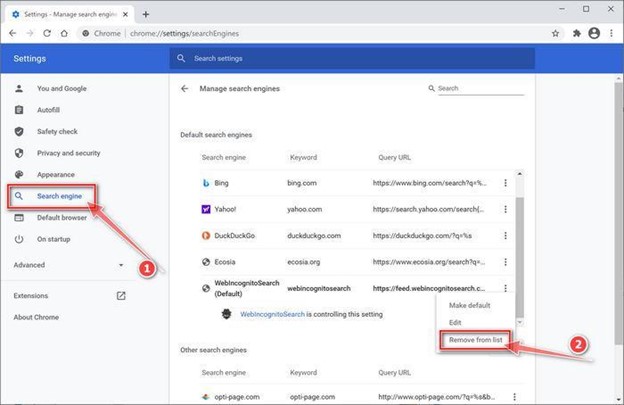
Next, find Google Search, click the three vertical dots and select “Make default“.
3. Check the homepage and new tab settings.
In the upper right corner, click on Chrome’s main menu button, represented by three vertical dots. When the drop-down menu appears, click on “Settings”.

In the “At startup” section, disable the malicious extension, then select “Open new tab page” as your preferred setting.
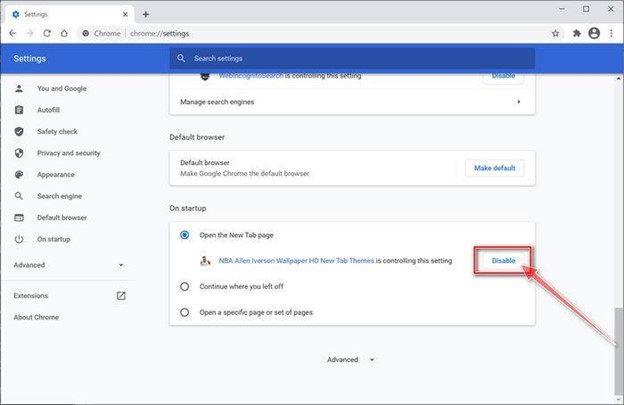
Warning
If your browser is still redirecting to malicious websites or you may see popups after performing the above steps. We highly recommend resetting Google Chrome to its default settings.
To do this, type “chrome://settings/reset profile settings” in the URL bar of your browser and click on “Reset settings”.
Firefox
Remove adware and malicious browser extensions from Firefox
To remove adware and malicious browser extensions from Firefox we reset the browser settings to their defaults. The reset feature solves many problems by restoring Firefox to its factory default state while saving your essential information such as bookmarks, passwords, web form auto-fill information, browsing history, and open tabs.
1. Click the “Menu Icon” click on “Help”.
Now you can click Firefox’s main menu button, which is represented by three horizontal lines. When the drop-down menu appears, select the option labeled “Help“.
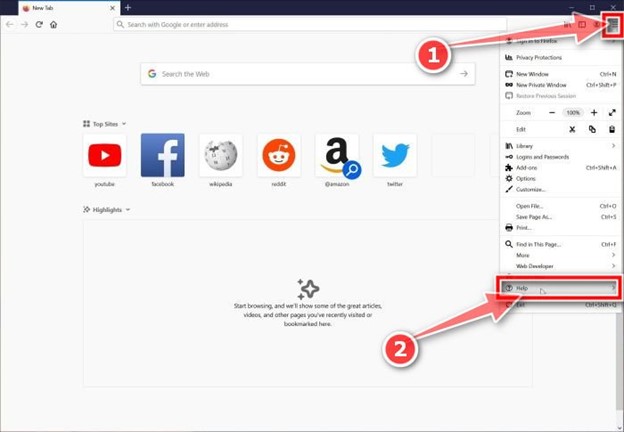
2. Click –>“Troubleshooting Information”
From the Help menu, click on “Troubleshooting Information“.

3. Click on “Refresh Firefox”
Click the “Refresh Firefox” button in the upper-right corner of the “Troubleshooting Information” page.

4. Confirm.
To continue, click on the “Refresh Firefox” button in the new confirmation window that opens.
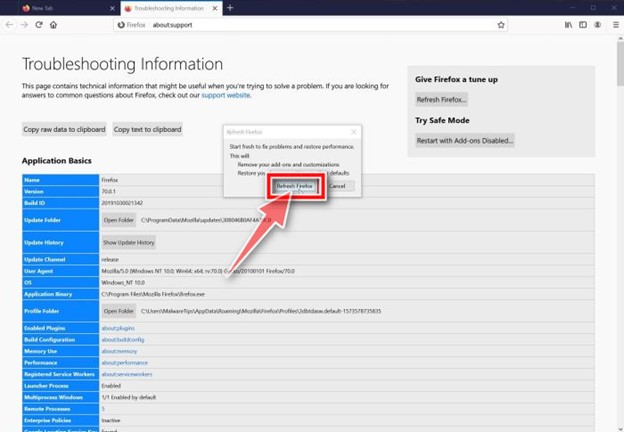
5. Click “Finish”.
Firefox will close itself and return to its default settings. When it is finished, a window will list the imported information. Click on “Finish”.
Your old Firefox profile is kept in a folder called “Old Firefox Data” on your desktop. If the reset didn’t fix your problem, you can recover some of the saved information by copying the files to the new profile you created. If you no longer need this folder, you should delete it as it contains sensitive information.
Microsoft Edge
Remove adware and malicious browser extensions from Microsoft Edge
To remove adware and malicious browser extensions from Microsoft Edge we reset the browser settings to their defaults. This will reset your start page, new tab page, search engine, and attached tabs. It disables all extensions and clears temporary data like cookies. Your favorites, history, and saved passwords will not be cleared.
1. Open the “Settings” menu.
In the upper right corner, click on Microsoft Edge’s main menu button, represented by three horizontal dots. When the drop-down menu appears, then click on “Settings“.
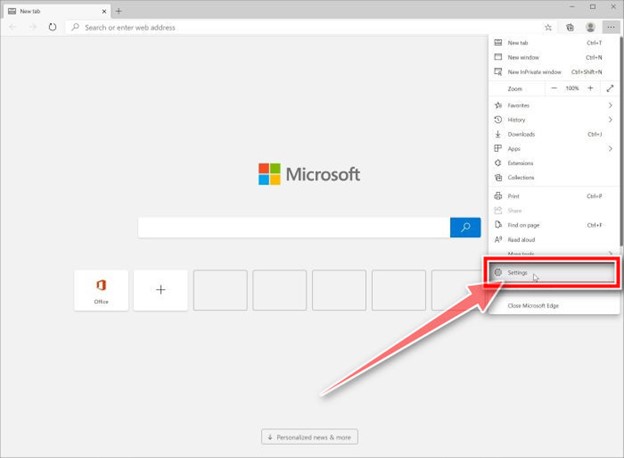
2. Click –> “Reset Settings”.
remove malware of Microsoft edge
3. Click –> “Restore Settings to their Default Values”
Now you can click on “Restore settings to their default values” in the main window.
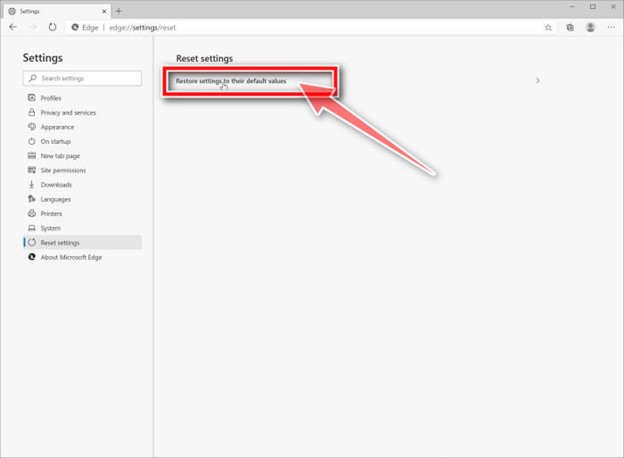
4. Click –> “Reset”.
A confirmation dialog should now appear detailing the components that will be restored to their default state if you continue with the reset process.after that click the “Restore” button to complete the recovery process.
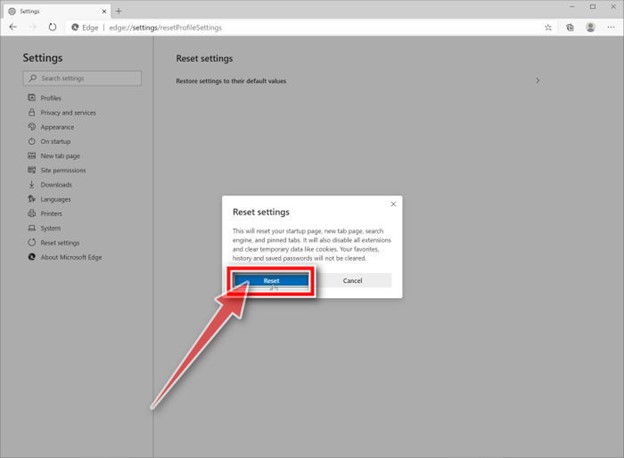
Your Windows 11 PC should now be free of malware. If you still experience problems while trying to remove malware from your device, you can ask for help in our Windows Malware Removal Help & Support forum, where trained professionals are ready to help.
